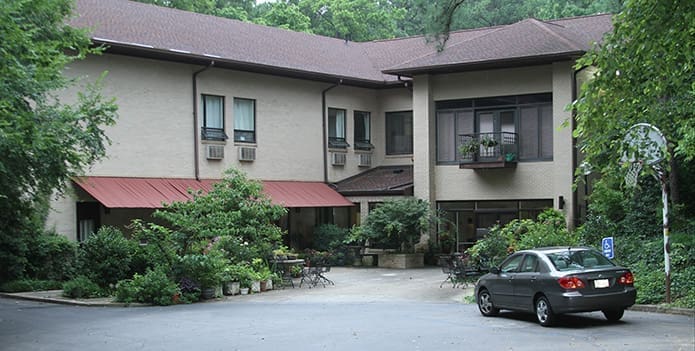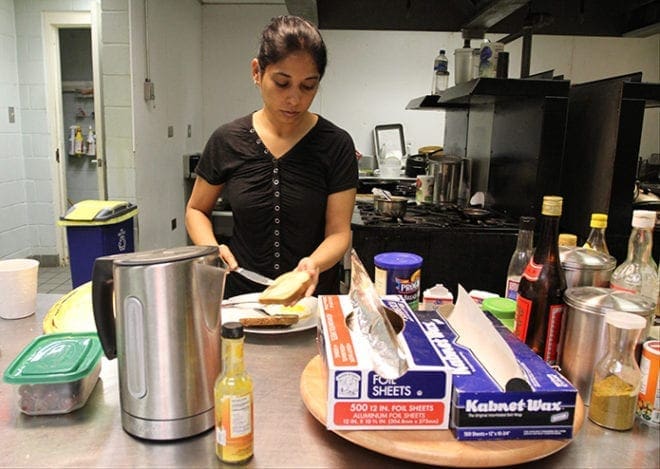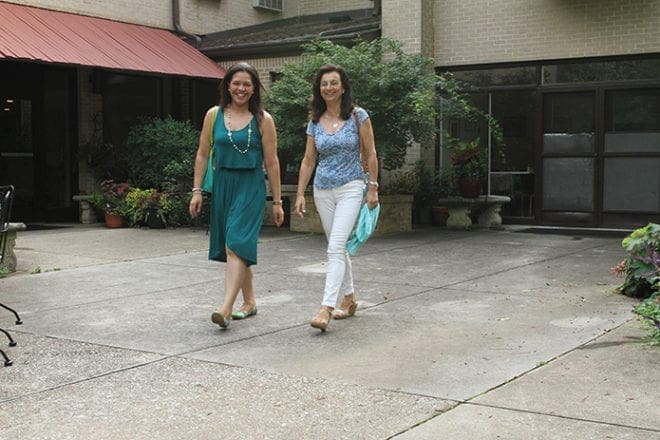 Photo By Michael Alexander
Photo By Michael AlexanderDecatur
Villa International: An oasis of friendship in Decatur
By JEAN DRISKELL, Special to the Bulletin | Published August 1, 2013
DECATUR—Just north of Emory University and the Centers for Disease Control and Prevention is an oasis called Villa International Atlanta on Clifton Road, where people from around the world come to study and do research at Emory’s Rollins School of Public Health and the CDC, as well attend other universities and seminaries in Atlanta.
The two-story, L-shaped building is tucked away from the road and surrounded by trees. From the outside, it looks like its name, with its beige walls, red roof and awning, and patio in front with umbrella tables, chairs and flowers. Visitors may be greeted by Maggie, the resident tiger-striped cat, who walks around the place like she owns it. She belongs to Camille Gaffron, Villa’s executive director.
“We’re more of a home than a hotel,” Gaffron said.
She is Villa’s eighth executive director and has been there for 15 years. It was founded by the Reverend Harry F. “Pete” Petersen, a Presbyterian minister.
The idea for Villa came about when a young woman from Africa who was studying at the CDC committed suicide on Easter weekend in 1966. At that time people coming to the CDC to study and do research found looking for housing facilities challenging, and some could only afford substandard accommodations.
A U.S. State Department representative “asked the churches in Atlanta to come up with a way to house international peoples close to CDC,” Gaffron said. “It had to be an institution. It took five years for the idea to be generated and the monies raised before a building could be built.”
Seven churches or denominations are actively involved, Gaffron said, “with the Catholic Church being involved since the beginning.”
Currently 35 guests from 21 countries are staying at Villa.
“Most of our guests are very well educated, sophisticated and well traveled,” Gaffron said. “There are some who come here who are away from their village for the first time. Many have studied in their fields all over the world. They are usually the brightest and the best from their countries.”

Standing in the kitchen, Rubina Tabassum of India butters her toast as she prepares to eat breakfast before departing to work. Photo By Michael Alexander
“It’s like living in a big family,” she said. “They share rooms, play together, and we take them on trips, like visiting St. Augustine or Panama City, Florida.”
Villa is financed with contributions from various churches, organizations, foundations and trusts.
“Immaculate Heart of Mary has always been a part of our ministry,” Gaffron said.
IHM parishioner Bettie Messner is a former board member and Deirdre Holler, from Corpus Christi Church, Stone Mountain, and Joan Lucas, from Holy Family Church, Marietta, are currently on the board.
Holler, who is also on the board of the Atlanta Archdiocesan Council of Catholic Women, said that she got involved with Villa through the AACCW in the early 1970s when she moved to Atlanta. The AACCW has assisted Villa since its inception, and the Atlanta Archdiocese contributed funds during Villa’s early years. Holler said that the AACCW contributes $500 a year to Villa.
“I found Villa to be very, very interesting,” Holler said. “It may be because I was an immigrant myself. What really impressed me were all the different denominations that were involved with Villa.”
She was invited to join the cultural and social committee and continues today as the chair of that committee.
Villa ‘runs on volunteers’
“This is truly an ecumenical ministry,” Gaffron said. “It takes all the folks who have the heart to help the world. We run on volunteers.”
Gaffron herself is a “jack of all trades” at Villa. She lives there and makes sure that anything that needs to be done is done.
“I run the operations, do fundraisers, stock toilets, provide a shoulder to cry on, do gardening, help cook for big events, and clean rooms,” she said.
The staff consists of two full-time housekeepers, two part-time office clerks, a part-time bookkeeper and a part-time development director.
Several groups provide a welcoming dinner when a big group arrives at Villa.
“It means something for the guests who come here from all over the world,” Gaffron said. “The dinners are a welcoming event and help the guests to feel at home, break bread with each other and share hospitality. It is a far easier way to interact with one another over dinner.”
When the Hubert Humphrey Fellows come for a week in March to study in their respective fields, their welcome dinner is hosted by the AACCW. This year 90 people—guests, staff and volunteers—shared the meal and got to know a little about each other.
“AACCW started doing the dinners soon after I joined the cultural and social committee,” Holler said. “The dinners were always under this committee. At times, AACCW would host two or more dinners in a year when needed. At present, we host only the Humphrey Fellows in the spring.”
Other events include a Mother’s Day tea, which started in 2002 as a Valentine’s Day tea. It was moved to Saturday of Mother’s Day weekend three years later.
“Our women volunteers are invited and honored,” Gaffron said. “We raise about $2,000 every year.”
“I always enjoy being around the guests at Villa,” Holler said, “and seeing how well they get along with each other. Just the joy on their faces for being able to stay at Villa, being a part of it brings me much joy.”
Villa connects people from around the world
At Villa, “lots of nice connections are made. We match people from around the world to the volunteers,” Gaffron said. “We are friendship evangelization. We show Christ’s love through hospitality. We don’t try to do evangelization. We celebrate our differences and diversity.”

Shirley Aljure of Colombia, left, and Immaculada Romero-Fernandez of Spain leave Villa International Atlanta on their way to work at the Centers for Disease Control and Prevention (CDC). The international residents they host take on a variety of roles such as students, researchers, interning doctors, public health professionals and seminarians. Photo By Michael Alexander
Christelle Evans has lived at Villa since Jan. 14, 2011. She remembers the date exactly because she moved to Atlanta during a blizzard and had trouble getting from the airport to Villa. Evans, who is in the process of being ordained for the United Methodist Church, is from Chicago.
Villa “wasn’t what I expected,” she said, adding, “I didn’t fully know about Villa’s mission,” but she knew it was a place where international people stayed.
“What I ended up learning is that Villa is a wonderful community of people from all over the world.” Her time at Villa has been “a wonderful eye-opening experience for me … cross-culturally, geographically.”
Gaffron said that former residents call or text her or friends at Villa.
“Most of the researchers here are serious people. When they leave here, they go back home to continue their work or go to other parts of the U.S. or other countries to continue their studies. This is their family,” Gaffron said. “Many times, those who don’t have families feel family here at Villa. Many come back.”
Evans said that she’s made many friends at Villa. She said, “I have invitations from all over the world. I’ve met people from every country in South America, except one. And I have invitations to visit all of those countries.”
Gaffron said that after doing a day of intense research, guests need a place to relax and eat well. “When one has a paper published, that person has friends at Villa to celebrate. You have someone to listen to you when you have a bad day. For example, you have a research project that fails, you need a community to support you,” she said.
Gaffron said that the guests, when back home or aboard, will come up with any excuse for a Villa reunion.
“They have a common history that makes a bond, a friend,” she said. “Our mission connects the world. It’s very hard to be in this place and not connect with the world. Many form everlasting relationships. We even have Villa marriages where couples have met at Villa.”
“Most of our guests have grants, stipends and fellowships and come by invitation from the CDC,” Gaffron said. “The epidemiology course has 80 plus people in its group, making them the largest group to come every year.”
The dinners, teas and some other events are set in the living/game room area on the first floor.
There is also a library and a chapel/holy space room overlooking the peace garden. There are Bibles, prayer rugs for Muslims, and candles for Hindus. On the far wall is a large wooden cross. There are 33 rooms with at least two beds in them; four rooms have three beds and four have four beds. The guests have access to a fully equipped kitchen, and a laundry room is on the second floor as well as an exercise room.

(L-r) Christelle Evans, one of two of the 39 residents from the United States, joins Maria Gomes of Brazil, Camille Gaffron, Villa International Atlanta executive director, and Amanda Oliveira of Brazil in front of the collection of crosses from different cultures around the world, commonly known as the “Jesus Wall.” Photo By Michael Alexander
Throughout Villa is artwork donated by the guests from around the world.
“They look for their culture on the ‘Jesus Wall,’ as the guests call it,” Gaffron said, “and if no cross from their culture is there, they’ll bring one on their next visit. No matter what their faith, they take pictures in front of it.”
“They look for signs of home,” Gaffron said. “They also look for their home flag, if not there, they send one to us. They share where they’re from, their culture and traditions.”
“It is a rare opportunity for those from closed cultures to see and be exposed to other ideologies, people, and cultures,” she said. “By learning their culture you understand your own.”
Evans said that she “bubbles over” when she talks about Villa.
“It’s been an unexpected gift.”